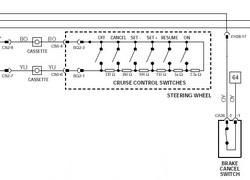
Follow Safety Instruction, AIRBAG removal!
Possible Airbag detonation! Not to follow Safety Instruction may lead to personal injury!
If you are a non professional, you shouldn't be working on a cruise control system without adequate training.

On this Jaguar, I had a cruise-control malfunction, motor management went into
safe-mode, there wasn't any apparent cause saved in the PCM's memory (miss interpretation of incoming voltage
levels that were out of their parameters, no fault codes on wheel-sensor or other dynamically measuring sensory).
The cruise control is fully managed by the ECM and the electronic throttle. Its
engaged, disengaged, adjusted through voltage level changes which are induced through the multi-function cruise control
switches integrated resistors.
Total series resistance 4310ohm, (with all switches open!), with a switch pressed,
for instance: off=0, cancel=120, set-=300, set+=600, resume=1110, on=2110, all values in ohm, +/- a percentage point,
measured at the clock spring output, the Brake-Cancel-Switch, which sometimes get's sticky, simply breaks a
voltage supply to the PCM (high to low).
My first thought, the clock-spring got crappy, ABS warning indicator wasn't illuminated, all other steering wheel
functions were still available.
So, what did do, find the connections coming out of the clock spring (BO/YU),
calculate the total series resistance of the cruise control resistors (see Jtis),
clamp Multi-meter, turn the steering wheel to each end, back and forth, see if the resistance changes (short/open),
if it changes, replace the clock spring, also, check each switch resistance and its proper function (see above note).
I decided to remove the Air-bag unit (Safety first! follow safety instructions on JTIS (possible detonation!)), to view
the cruise control function switches,
cleaned contacts with contact spray, checked the resistances of the circuitry (see above).
Further, I removed the cruise Brake-Cancel-Switch, with the use of a Multi-meter check that both switches
function correctly (don't stick), sprayed contacts. Problem didn't occur any more.
General Service Information
General Service InformationRear axle
Rear sub-frameFront axle
Lower ball-point joint, Shock absorber bushes, Stabilizer bar links + mountsBrake disc and pads
Engine
Intake Manifold / Ignition Coils / Spark-plugs/ engine-block ventilation (elbow)Injectors
Starter system
Valve clearance, timing-chain, tensioner and glides:
With valve clearance in its tolerance,
there was no need to take the camshafts down, so tensioners and co. have to wait, the good thing is the
tensioner pumps up in 3-4 min. the rattle noise disappears.
Cruise control malfunction, emergency mode
Automatic Transmission 5R55N
Info, tips, Fail Safe ModeStall Speed Test procedure and diagnoses
Valve Body, known issues
Valve Body, Solenoid test procedures
Line Pressure Test
Self made press for pressing down clutch drum springs, checking clutch tolerance without a dial gauge
Chassis
Air ConditioningMiscellaneous repairs
Wind-shield-wiper mechanism:
Time on the lot took its toll, wind-shield-wiper shafts had seized,
uninstalled the mechanism, freed the seized shafts through the use of a good rust loosener, heat, force.
Water in Spark-plug wells 3-2 cylinder:
After days of heavy rain the engine began to misfire with
accounted trouble codes, spark-plug wells were wet, an ionized rusty red path on the ceramic insulator had developed which shorted the
HV ignition spark.
Radio:
Connected the radio controls to the multi-functional steering wheel using
an analog digital converter.
